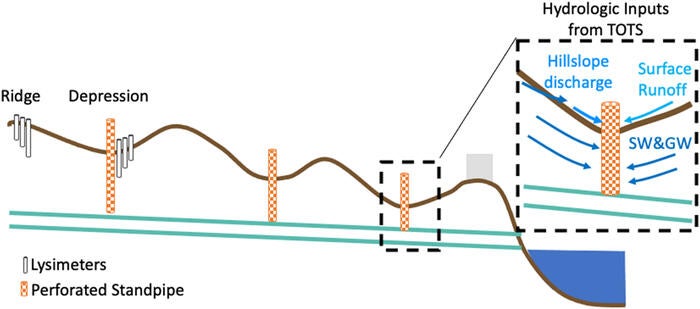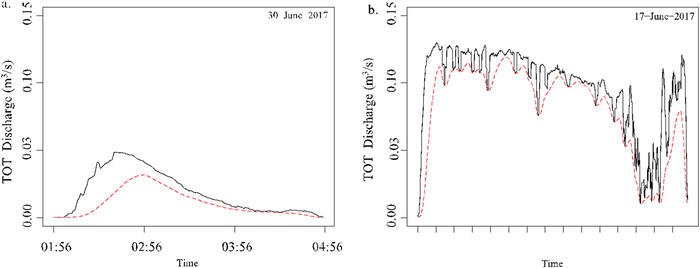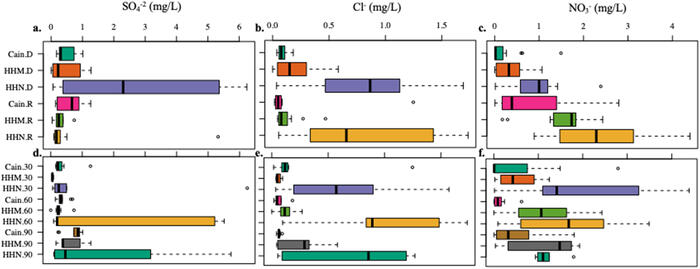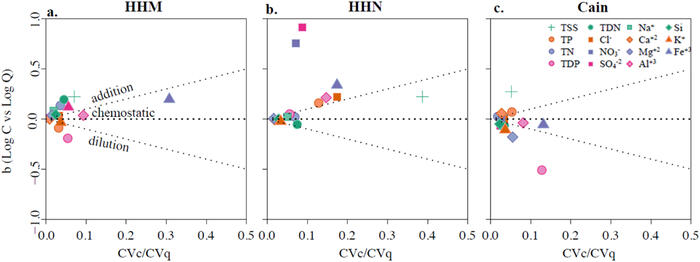 Contact
Contact
 Andrea Brookfield,
Andrea Brookfield,
Department of Earth and Environmental Sciences
Introduction
Agricultural practices in intensively managed landscapes are thought to be shifting hydro-biogeochemical behaviour from transformation to transport dominated systems where increased flow rates and shorter residence times decrease water-mineral interactions. Tile outlets (subsurface drainage systems that collect surface and shallow subsurface water through perforated pipes and transport them through unperforated horizontal pipes to a receiving pond) and terraces (constructed, horizontal areas created to divide sloping terrains by reducing slope steepness) are two best management practices used to reduce the impact of overland flow on soil erosion in agricultural environments. Since the 1960s, tile-outlet-terraces (ToT) have combined the use of tile outlets and terraces to further reduce surface water runoff and erosion during storm events. While the impact of tiles on hydrologic behaviour has been well studied, the combined impact of multiple, interacting surface and subsurface manipulations on landscape hydrology and the cascading biogeochemical response has not. This study explores the impact of TOT density on discharge following storm events and how altered hydrology impacts biogeochemical behaviour.
Methodology
The study was conducted across three adjacent agroecosystems with similar landscape and management characteristics in the Upper Wakarusa River Watershed in Kansas, United States over the 2016 to 2018 growing seasons. All sites were terraced with ridges and depressions, had perforated standpipes located in depressions that were connected to tile outlets to help drain standing and soil water, and had non-perforated tile drains connected to wetlands before being discharged to nearby streams. Data was collected to characterize flow and transport at study sites and included measurements of precipitation, velocity and stage from each discharge location. Discharge and soil waters were also collected and analyzed to characterize the biogeochemical response to storm events (Figure 1).

Figure 1: Conceptual diagram of a tile-outlet-terrace drainage system. In this work, suction cup lysimeters were placed at the terrace top (ridge) and bottom (depression). Hydrologic inputs include surface water runoff, soil water (SW) and groundwater (GW), as well as hillslope soil water and groundwater that discharge to the land surface and then are captured by the standpipe (see inset in dashed box).
Data analyses included the use of recession curves, end member mixing analysis, and concentration-discharge relationships to understand the impact of TOTs on the hydrologic flow and transport behaviour of the landscape.
Outcomes
The study found that baseflow contributed between 38 and 51 percent of discharge at the three sites and that baseflow values showed little relationship to tile inlet density. At all sites, long duration storm events caused a high frequency response to be superimposed on the typical low frequency hydrograph response, suggesting that TOT systems provide a mechanism for pulsed discharge that is not normally observed in unaltered landscapes (Figure 2). A possible mechanism for this pulsed flow is the transition from negative to positive pore pressures in the capillary fringe when it is located at depths consistent with the tile system.

Figure 2. An example of tile-outlet-terrace (TOT) discharge behaviour (black line) and the proportion of baseflow (red dashed line) for (a) short events and (b) long events estimated using a recursive digital filter.
The results show spatial and temporal variability in waters that contribute to TOT discharge which is likely a function of both the storm intensity and antecedent soil moisture conditions. Under dryer conditions, storm event water appeared more closely connected with TOTs and the residence time of the water was extremely low with large macropore cracks open. Low precipitation and high evapotranspiration may strongly influence change in soil fabric reducing the time water interacts with the soil matrix and thus not allowing the soil matrix to alter the chemical behaviour of the infiltrating water before it discharges the TOT. Under wetter conditions early in the growing season, the strong spatial variability in the contributions of water suggests changing flow paths are likely occurring where water is being contributed from shallow soils in the terrace ridges and depressions and from direct overland flow.
The largest variation of nitrate concentrations was found at depths of 30 and 60 cm on terrace ridges, while sulfate concentrations were highest in terrace depressions with the largest variations found at depths of 60 and 90 cm (Figure 3). This suggests that during storm events shallow ridges are a significant source of nitrate. It was also observed that later in the growing season, when the system is rewetting, that storm events may have a greater residence time imparting a signature of ridge and depression soil water.

Figure 3. Average concentration (center line), standard deviation (extent of boxes), and 10% and 90% percentiles (extent of dashed lines) of sulfate (SO4; left), chloride (Cl; middle), and nitrate (NO3; right). All three sites are presented based on position of the lysimeters as “ridge” (site R) and “depressions” (site D) in the top row and by depth (30, 60, and 90 cm) in the bottom row.
Concentration-discharge relationships showed that solute behaviours varied across sites. Most sites, however, demonstrated chemostatic behaviour where solute concentrations varied relatively little compared to changes in discharge across all tile densities. When observations were coupled with metrics of flashiness, the greatest degree of flashiness was the site with the most chemostatic behaviour. These data were inconsistent with the expectation that more chemodynamic behaviour would be associated with higher tile densities and more flashy hydrograph responses. (Figure 4).

Figure 4. Slope of the stream water concentration-discharge (C-Q) compared to the coefficient of variation of the concentration to the discharge (CVc/CVq) for solutes at the three sites: a) HHM; b) HHN; and c) Cain. Values of − 0.1 < b < 0.1 and CVc/CVq < <1 are considered chemostactic.
Conclusions
The change in hydrology resulting from intensively managed landscapes affects the transformation, transport and fate of fertilizers and their effect on other solute behaviour. The study expected an increased density of TOTs to increase the flashiness of the hydrologic response, however results were not consistent with this expectation, indicating that other hydrologic features were also significantly contributing to the flow response. The interaction of TOTs did lead to irregular storm water discharge events and hydrological flow responses with both low and high frequency signals. While the low frequency signals were consistent with responses in unaltered landscapes, the study suggests that the high frequency signal may be due to movement of the capillary zone within the area of the tile drains.
Mixing model results suggested that other mechanisms may control spatial and temporal variability in hydrologic controls on TOT discharge. Specifically, event water appears to move unaltered through the soil fabric under dry conditions when large soil cracks are present. Conversely, the soil fabric has strong spatial control due to increased residence time early in the growing season when these preferential flowpaths are not present and antecedent conditions drive both toward the terraces and tiles.
The concentration-discharge responses of the agroecosystems were also inconsistent with expected results, as it was expected that more chemostatic behaviour would accompany lower tile densities and less flashy hydrograph responses. This study found that while the TOTs contribute to changes in the hydrologic and biogeochemical behaviour of the sites, that antecedent conditions and the storm event size were more significant drivers of the flow and biogeochemical responses.
Further work is needed to assess the controls TOTs have over hydrologic and biogeochemical responses to storm events in different environmental conditions, particularly in regions without significant preferential flow paths that can obscure and dominant system response.
Stops, M. W., Sullivan, P. L., Peltier, E., Young, B., & Brookfield, A. E. (2022). Tracking the hydrologic response of agricultural tile outlet terraces to storm events. Agricultural Water Management, 263, 107382. https://doi.org/10.1016/j.agwat.2021.107382
For more information about WaterResearch, contact Julie Grant.
Photo: Polyethelene corrugated drainage pipe, by Dwight Burdette. CC-BY-3.0 Wikimedia Commons, no changes.






